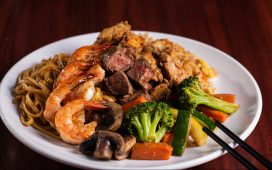Table Of Contents
The United States (US) is famous for many reasons, but most people often overlook this one until they have traveled to the US is the shocking culture of fast-food consumption. This trend is clear from the staggering number of fast-food chains scattered all over the country.
Here is a pretty intriguing fact, according to a study by Open Table, in New York City alone, you can eat at a different restaurant once a day, every day for 22.7 years, and never go to the same spot twice. The survey results paint a clear picture of the state and culture of American cuisine.
However, be that as it may, specific groups or demographics of the US population still enjoy the tradition of preparing home-cooked meals. Home-cooked meals in the US are synonymous with barbeques, crab boils, cook-outs, and soul food.
Typically, this portrays a narrative that home-cooked meals cannot be healthy. They have to be oily, greasy with exorbitantly high amounts of sugar and salt. Although, this is not at all true.
Below, we list some practical ways that you can make surprisingly healthier and delicious meals from the comfort of your home.
Avoid Buying Processed Food
The journey of cooking healthy home-cooked meals begins when buying your groceries. The first rule of buying groceries is “No Processed Food.” Processed food is any food product altered from its natural state, typically for preservation purposes.
Additives and preservatives extend the shelf life of food by stopping the growth of bacteria and molds, which spoil the food and ultimately make it unsafe for human consumption.
Processed options have excessive amounts of added salts, sugars, and fats. While canned consumables are put in syrup and broth, both of which contain high levels of sugar and salt. Instead, buy healthy foods and prioritize organic and free-range options.
Minimize Your Use Of Salt
There is a substantially common misconception that sugar is unhealthier than salt. This misconception is far from the truth. Too much of this in your diet could lead to heart disease, high blood pressure, and stroke. Avoid using too much salt in your home-cooked meals by first tasting it. To make sure that you add as little as possible, use a grinder or the tips of your fingers.
You may use salt alternatives such as olive oil, lemon juice, and vinegar to enhance the flavor. These ingredients have a similar taste effect as salt.
Use Sugar Alternatives
Sugar, or more accurately, processed sugar, is one of the unhealthiest food products in the world. As a result, food technologists and scientists have researched and found a plethora of natural sweeteners that are easily found in nature and have far less effect on the human body than processed sugar.
Natural sweeteners are substitutes or alternatives for traditional sugar—popular sugar alternatives are monk fruit products. Monk fruit is a tiny green melon native to the South of China. Its extract is over 200 times sweeter than table sugar, has no calories or carbs, and does not raise blood glucose levels.
Cook With Liquids, Avoid Using Oil
Explore cooking with liquids such as stock or broth, wine, lemon juice, vinegar, soy sauce, or just plain water. This process is known as oil-free cooking.
Each liquid, however, has its pros and cons. Broth, for example, has half the number of calories as stock, while stock contains more carbs, fat, and protein. The stock also contains slightly more vitamins and minerals.
Avoid Deep-Frying Your Food
To further decrease or altogether avoid the use of oil in your cooking, prepare your food by either steaming, baking, grilling, roasting, or braising. These methods require little to no oil for food preparation. Another way you can achieve oil-free cooking is by using your microwave, oven, or air fryer.
Deep-fried foods have high levels of trans-fats that are hard for the human body to break down, leading to a substantially enhanced risk of a heart attack, stroke, and type 2 diabetes.
Use Herbs To Enhance Flavor
Use herbs as flavor enhancers in your meals. They are also alternatives or replacements for ingredients such as salt and oil. Dried herbs are more potent and flavorful than fresh ones.
Herbs are versatile and can enhance hot foods, such as soup or veggie stews, and cold foods, such as vinegar, beverages, and salad dressings.
Don’t Overcook
One thing that often gets overlooked when cooking is the impact of overcooking on the vitamins and minerals found in the ingredients. Overcooking leads to a drastic loss of nutrients in some food products, especially those with vitamins and minerals that are water-soluble.
To avoid reducing or completely losing nutrients in your home-cooked food, opt to use the microwave or oven to prepare your meal. Make sure to minimize the amount of water you use when boiling veggies. You can also scrub your veggies instead of peeling them, as more nutrients are closer to the skin.
Start A Veggie And Herb Garden
One way to make sure that your home-cooked meals are healthy is only to consume products (fruits, veggies, herbs, or nuts) that are 100% organic and GMO-free. Starting your veggie and herb garden will provide you with an unlimited supply of fresh seasoning and produce.
Experts say that 80% of the food in supermarkets contains ingredients that come from genetically modified crops. Although GMOs offer some advantages to farmers and consumers, such as more excellent protection against pesticides and an increase in the general nutritional value of some food products.
There are some severe and dire disadvantages to using GMOs. GMOs can cause toxicity, allergic reactions, and, even worse, cancer in humans. Therefore, you should start an organic garden or small-scale farm, depending on your availability and space.
In closing, always remember that cooking and eating healthier does not mean giving up your favorite food. You just need a few alternatives/replacements and a little bit of imagination, creativity, and the internet.






